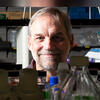In The News: School of Life Sciences

“We really are more than human. They’re on us; they’re in us; they’re everywhere.” My body, Brian Hedlund casually tells me, has 10 times more microbial cells than human, around 100 trillion. So much for hand sanitizer.
The bees are in the air early at the University of Nevada at Las Vegas. Joseph W. Margotta, a graduate student working in the honeybee-physiology lab, is making them fly sooner than normal and measuring any extra damage this stress might bring to their DNA and cells.
Even in places as seemly well-studied as the national parks of North America, new species are still being discovered. Using ultraviolet light that cause scorpions to fluoresce a ghostly glow, researchers from the University of Nevada, Las Vegas (UNLV) have discovered an intriguing new scorpion in Death Valley National Park. They named the species Wernerius inyoensis, after the Inyo Mountains where it was found. The study was published in the open access journal ZooKeys.
This is the second time a new species is found in the mountains, which is unusual; unclear of how venomous creature is.

